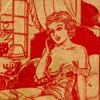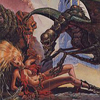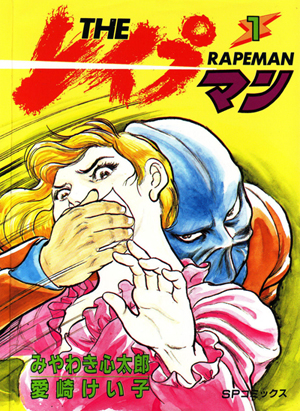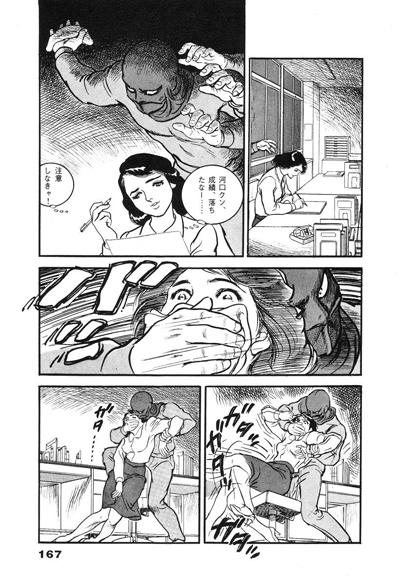The Rapeman: The Weirdest Japanese Superhero?!
|
The Rapeman (レイプマン) is a black comedy/satirical Japanese manga series for strictly for adults, featuring one of the weirdest anti-heroes ever as its central protangonist. It was originally credited as being created and written by someone called Keiko Aisaki, and illustrated by Shintaro Miyawaki. However it later transpired that Keiko aisaki was a fictional pen-name of the "illustrator" Miyawaki. He created the pseudonym to deflect any of the controversy that he expected from writing a manga series based around such a theme as a rapist superhero. The series ran from 1985 to 1992, for 13 volumes, and was aimed at middle-aged Japanese men. As well as manga artist, Miyawaki is also known as an gekiga artist. Meaning "dramatic pictures", it is a genre of comic book art that is considered a more serious form of social commentary than the "whimsical pictures" nature of manga. That's right, The Rapeman in Japanese culture is part of manga, and therefore in the category of comic whimsy.

Bizarre Profiles: Yoshihiro Tatsumi - Read about the Japanese comic book artist Yoshihiro Tatsumi, who is widely credited with starting the gekiga (劇画) style of alternative adult comics in the country in 1957. Known in the west for his anthology Good-Bye And Other Stories (1988).
|
|
The main character of Rapeman like all superheroes, has a secret identity. He is Keisuke Uwasaki, a mild-mannered, handsome high school tecaher by day. He transforms into the anti-hero Rapeman at night, to dispense his weird and creepy form of "justice". Uwasaki runs a business called "Rapeman Services" with his uncle, a former surgeon. The motto of the business is, "Righting wrongs through penetration." Clients call on the Rapeman to handle cases such as the revenge of a jilted lover, forming parental bonds through a traumatic crisis, making disruptive co-workers more docile and other things of an equally mind-bogglingly bizarre nature. When engaged in his night-time trade, the Rapeman wears a black leather ski mask shaped like the head of a penis, but no trousers or underwear. In the middle of a rape, if the woman becomes unresponsive or expresses enjoyment, he uses special techniques such as "M69 Screwdriver" or "Infinite Loop" to apply more pain to the victim. Despite regretting some of the contracts he undertakes as part of "Rapeman Services", Uwasaki always does what he is asked.
As well as the 13 volumes of manga comics, there has also been a short lived The Rapeman animation series, based on the first volume, it ran for two episodes. In addition there have been seven live-action movies, running from 1993 to 1995, and two spin-off movies in 1996. The movies, despite still having the central rape as revenge theme, are toned down considerably from the manga series. And equally bizarrely, again despite the aforementioned central theme, The Rapeman movie series are less sexual and less violent than earlier movies that fall into the Pink Film genre. |
The Rapeman as a character, needs to be put into context within Japanese culture to be understood. On an immediate reactionary level the whole concept mean appear utterly abhorrent, but remember that the comic series was originally written as dark satire. As mentioned earlier the creator of the series Shintaro Miyawaki is also known as a gekiga artist. Like the work of the godfather of gekiga, Yoshihiro Tatsumi, these works often focus on the sexual disempowerment of older men within Japanese culture. After their defeat in WWII and the inability of particularly men to cope with the massive cultural changes that happened in Japan in the latter half of the 20th century. As Japan was in many ways forced to engage with the western nations, and open up. The vast rebuilding programs and expansion of the cities in the country, as well as the rapid industrialisation, left many behind. For many men of a certain age, they felt both disenfranchised and disempowered by what was happening around them, and that affecting change was out of their control. For a culture that prides itself on being a controlled sea of calm, repressed emotions need an out-let. In that context, the character of The Rapeman can be seen as representative of that repressed emotion expressed in satirical comic book form.
|
|
The series and character of Rapeman came prominence outside of Japan when Steve Albini and Rey Washam became "sort of obsessed" with the comic book series, and named their new group after the titular anti-hero in 1987. Rapeman's performances would often be the target of protesters, who felt that the band was mocking or even encouraging rape and violence against women. Also in 2003, when the infamous Super Free rave club in Tokyo was exposed as running what foreign journalists labelled as a "rape club". The club was started as a rave event club, by Shinichirō Wada and other students of Waseda University, member for which would scout out intoxicated girls at events to lure into back rooms for sexual exploitation and rape. Wada was arrested on June 9th, 2003. 13 other club members were also arrested for gang rape.
|

Banned 80s Arcade Game: Lover Boy - Bizarre doesn't even begin to cover this Pac-Man style vintage arcade game, that unbelievably featured rape as its central theme.
|

Tijuana Bibles: Comic Book Porn In Your Pocket - The salacious story of early underground comic books, generally known as Tijuana Bibles. Little 8-page, wallet sized piece of pornography.
|

Tentacle Sex In The Movies - From Japanese historical drama, via Lovecraft inspired b-movie nonsense, to possession and alien abduction. A slip and slide through movie tentacle sex.
|

Sukeban: Japanese Girl Bosses & Girl Gangs - The phenomena of delinquent girl gangs in Japan and their representation in Japanese culture, particularly in Pinky violence movies.
|


